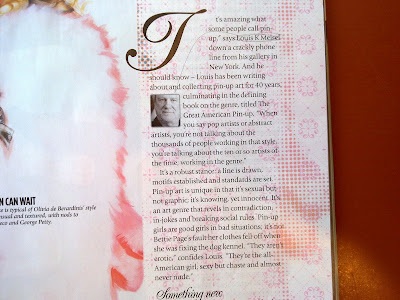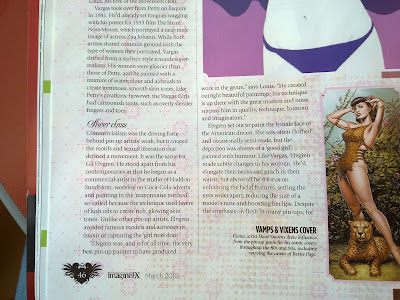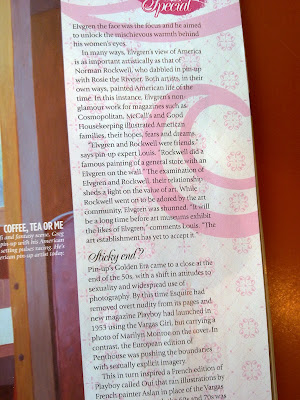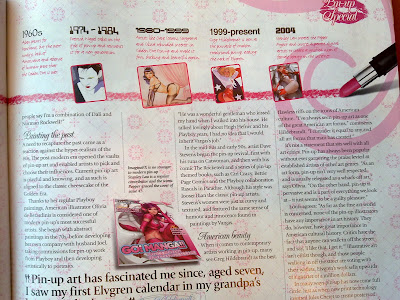If you've ever wondered what a film noir would be like if it starred cartoon cats, you can find out now. Felidae was a German production and was, or so Wikipedia tells me, the most expensive cartoon produced in Germany to that date. I find it so enticing because it's really a great story. A lot of time that could have been used to build better dramatic tension was missing, but I understand budget limitations associated with animated films. The only thing that I don't like is how so little was done with the femme fatale. One of the key tropes of noir is the morally ambiguous woman, and she was given very little time in Felidae. Otherwise, it's your standard 90-minute block and well worth a watch.
Thursday, April 29, 2010
Sunday, April 25, 2010
View My Older Post.
Because of the retarded way that Blogger handles posts, something I finished today is listed as though I wrote it, like, three weeks ago. So, go to it. It's great. You'll laugh. You'll cry. You'll stop.
The History of the Pin-Up
The History of the Pin-Up
Saturday, April 24, 2010
WATCH THIS: Horus- Prince of the Sun *UPDATE*
One of Hayao Miyazaki's earliest works (he was a "scene designer," an apparently made-up position used to give him credit for an inordinate amount of influence), Horus: Prince of the Sun is a wonderfully simple fable of a young man/boy (boyman... manchild?) fighting a demon.
Remember, this movie was from 1968, and Japanese animation was not the juggernaut that it is today. Quality was usually very poor, and storylines, far from the adult-oriented works of today, were aimed primarily at children. The animation work in Horus, while not up to Disney-snuff, is still very solid, expressive, and honestly, better than most of the stuff being made in Japan today.
At times, the movie is hilariously Japanese (really? We're going to break into song again?) and the trope of a demure female who has a magical voice is in full force (I'd love to see her in a cage match against the two midget babes that summon Mothra).
Still, the character of Hilda is much more interesting than many females in Japanese movies, and serves as a sort of preview to the powerful women that will populate Miyazaki's work over the next four decades. She's most like Sheeta, from Castle in the Sky, in that she's magical, quiet, and frankly, a little bit useless. Horus is also very much like Pazu (or Paizu as the American version sounds) in that he's incredibly capable, adult in almost every way but appearance, and wholly dedicated to protecting Hilda.
Set aside 90 minutes and enjoy some of the best early anime I've ever seen.
If you're watching on a big screen, which is best, make sure to select 480p on the parts that allow it.
UPDATE 6/16/2010:
Are you fucking kidding me?! Taken down because of a copyright claim. It's a 42-year-old cartoon that NO ONE except me and, like, three other people give a shit about. Go fuck yourselves, TOEI.
I've re-posted another upload of the film. If it gets taken down again, I'll track down another copy and post it. If it's not available still, go download Vuze, hit up Isohunt.com, and download it yourself. Then you'll have the whole thing in high quality and TOEI will have lost ANY chance of making money. Brilliant business strategy.
UPDATE 8/29/2010: AGAIN... TOEI has had the Youtube videos taken down. The NANOSECOND that they are available again I will post them. I am so fucking pissed.
For now, the video is available on Hulu, which I'm embedding, but its dubbed, adequately, and the video is somehow of lower quality than the Youtube copy. It gets the job done, but the original Japanese sounds betters. And for some reason is called "Little Norse Prince Valiant," which doesn't actually make sense.
I said it before and I'll say it again, TOEI can go fuck itself.
UPDATE 11/28/2010: Got it.
Here's the HULU copy in English dubbing.
Remember, this movie was from 1968, and Japanese animation was not the juggernaut that it is today. Quality was usually very poor, and storylines, far from the adult-oriented works of today, were aimed primarily at children. The animation work in Horus, while not up to Disney-snuff, is still very solid, expressive, and honestly, better than most of the stuff being made in Japan today.
At times, the movie is hilariously Japanese (really? We're going to break into song again?) and the trope of a demure female who has a magical voice is in full force (I'd love to see her in a cage match against the two midget babes that summon Mothra).
Still, the character of Hilda is much more interesting than many females in Japanese movies, and serves as a sort of preview to the powerful women that will populate Miyazaki's work over the next four decades. She's most like Sheeta, from Castle in the Sky, in that she's magical, quiet, and frankly, a little bit useless. Horus is also very much like Pazu (or Paizu as the American version sounds) in that he's incredibly capable, adult in almost every way but appearance, and wholly dedicated to protecting Hilda.
Set aside 90 minutes and enjoy some of the best early anime I've ever seen.
If you're watching on a big screen, which is best, make sure to select 480p on the parts that allow it.
UPDATE 6/16/2010:
Are you fucking kidding me?! Taken down because of a copyright claim. It's a 42-year-old cartoon that NO ONE except me and, like, three other people give a shit about. Go fuck yourselves, TOEI.
I've re-posted another upload of the film. If it gets taken down again, I'll track down another copy and post it. If it's not available still, go download Vuze, hit up Isohunt.com, and download it yourself. Then you'll have the whole thing in high quality and TOEI will have lost ANY chance of making money. Brilliant business strategy.
UPDATE 8/29/2010: AGAIN... TOEI has had the Youtube videos taken down. The NANOSECOND that they are available again I will post them. I am so fucking pissed.
For now, the video is available on Hulu, which I'm embedding, but its dubbed, adequately, and the video is somehow of lower quality than the Youtube copy. It gets the job done, but the original Japanese sounds betters. And for some reason is called "Little Norse Prince Valiant," which doesn't actually make sense.
I said it before and I'll say it again, TOEI can go fuck itself.
UPDATE 11/28/2010: Got it.
Here's the HULU copy in English dubbing.
Friday, April 16, 2010
Betty Boop Film Class Part 10
It's been awhile since my last Betty Boop Film Class, but you can look at the gap as representing Betty's big move. Today's selection, Stopping The Show, is the first cartoon to be credited as a Betty Boop cartoon. No more second billing. No more Talkartoons. This puppy is 100%, gen-yoo-wine Betty Boop.
Granted, 100% Betty of course means that we don't even see her until nearly halfway through the cartoon. I think that even at this late stage, the success of Betty was something of a surprise to Fleischer and his crew. They might have gone back and adapted some of their working scripts to include Betty, raised her profile, or simply left the scripts untouched. For example, Jack & The Beanstalk was less than a year before this cartoon, "starred" Betty, but actually featured the old Bimbo design.
First things first, the opening credits. Notice how they seem to rotate down in 3D space to face the audience. Ub Iwerks is credited with the creation of the modern multi-plane camera, which would become immensely influential in animation, but I actually think that Fleischer was more edgy and inventive. He would manipulate his animation in any way necessary to get something unique. While Iwerks and Disney were more interested in refining animation, Fleischer wanted to bend reality and animation together. Both endeavors are of great importance to animation history, but Fleischer gets overlooked.
So, we finally get a look at Betty at about 3:35, and some of Fleischer's priorities are pretty obvious. He never got very good at lip-syncing, likely because he saw it as unimportant. He wanted to grind out wild, visually impressive works that captivated the eye more so than the brain or ear. Just look at how well Betty's voice is synced, during the vaudeville-like part, in comparison to EVERY other voice in the film. Animating to voice is difficult, and it's obvious that Fleischer just didn't want to take the time except when it was absolutely necessary.
This is actually a pretty unimpressive film. Whereas other cartoons had singing set to something stimulating, Betty does pretty much nothing on screen. She just stands there. Truly, this episode wouldn't even be much worth mentioning if it wasn't Betty's first headlining film.
For those who are interested, Fannie Brice was a comedian of great fame back in the 20's, 30's, and 40's. She earned her comic bona fides in the famous Ziegfeld Follies, and developed a variety of characters and mannerisms that were well-known to a 1932 audience. The only woman today who fits the bill is Ellen, but I think other comedians who have a very specific on-stage persona would fit the bill.
Maurice Chevalier was another performer who rose to fame in the theater, and I think it's no surprise that Fleischer chose two vaudeville performers to mention in his cartoons. He came from Vaudeville and most of his work's aesthetic is rooted in vaudeville.
And, finally, while it might just be coincidence, but the ending of, and the general staging of, the entire film could be a grand introduction of sorts for Betty. It's her first film, she's headlining the show within the film, and the episode ends with the audience screaming for more, causing her to come out on stage and thank everyone for wanting her so badly. It makes we wonder if this was a message from Fleischer to his real-life audience. "Thanks so much for loving what I've made. There's more to come."
Granted, 100% Betty of course means that we don't even see her until nearly halfway through the cartoon. I think that even at this late stage, the success of Betty was something of a surprise to Fleischer and his crew. They might have gone back and adapted some of their working scripts to include Betty, raised her profile, or simply left the scripts untouched. For example, Jack & The Beanstalk was less than a year before this cartoon, "starred" Betty, but actually featured the old Bimbo design.
First things first, the opening credits. Notice how they seem to rotate down in 3D space to face the audience. Ub Iwerks is credited with the creation of the modern multi-plane camera, which would become immensely influential in animation, but I actually think that Fleischer was more edgy and inventive. He would manipulate his animation in any way necessary to get something unique. While Iwerks and Disney were more interested in refining animation, Fleischer wanted to bend reality and animation together. Both endeavors are of great importance to animation history, but Fleischer gets overlooked.
So, we finally get a look at Betty at about 3:35, and some of Fleischer's priorities are pretty obvious. He never got very good at lip-syncing, likely because he saw it as unimportant. He wanted to grind out wild, visually impressive works that captivated the eye more so than the brain or ear. Just look at how well Betty's voice is synced, during the vaudeville-like part, in comparison to EVERY other voice in the film. Animating to voice is difficult, and it's obvious that Fleischer just didn't want to take the time except when it was absolutely necessary.
This is actually a pretty unimpressive film. Whereas other cartoons had singing set to something stimulating, Betty does pretty much nothing on screen. She just stands there. Truly, this episode wouldn't even be much worth mentioning if it wasn't Betty's first headlining film.
For those who are interested, Fannie Brice was a comedian of great fame back in the 20's, 30's, and 40's. She earned her comic bona fides in the famous Ziegfeld Follies, and developed a variety of characters and mannerisms that were well-known to a 1932 audience. The only woman today who fits the bill is Ellen, but I think other comedians who have a very specific on-stage persona would fit the bill.
Maurice Chevalier was another performer who rose to fame in the theater, and I think it's no surprise that Fleischer chose two vaudeville performers to mention in his cartoons. He came from Vaudeville and most of his work's aesthetic is rooted in vaudeville.
And, finally, while it might just be coincidence, but the ending of, and the general staging of, the entire film could be a grand introduction of sorts for Betty. It's her first film, she's headlining the show within the film, and the episode ends with the audience screaming for more, causing her to come out on stage and thank everyone for wanting her so badly. It makes we wonder if this was a message from Fleischer to his real-life audience. "Thanks so much for loving what I've made. There's more to come."
Thursday, April 8, 2010
History of Pin-Ups
I love pin-up art. I love the character in it. I love the affectionate yet sexual portrayal of women in it. At its worst, it's rote pornography. But at its best, it's some of the greatest art in American history. Either extreme and everything in between is worthy of discussion, especially here... where I'm just trying to fill up space. For even the pornographic work has had, for better or worse, a measurable effect on American culture and sex ideas. Pin-ups adorn bedroom walls, fill magazines, and sell products. They both liberate women and trap them in a prison of preconceived notions and illogical ideals. From that perspective, I think it's an entirely tenable argument that pin-up work is greater work than the likes of Picasso, Rockwell, or other such "legitimate" artists.
ImagineFX, a British art magazine, has a long work-up of Pin-Up art and their history. They conducted a phone interview with Louis K. Meisel, who expresses the same dislike for much of modern pin-up work as me (and hopefully you). Considering that this guy knows enough about pin-ups to write a massive book on the subject, that his opinions frequently match up with mine makes me feel... right. Which is great, because I'm arrogant and self-centered, so being wrong really hurts.
They have interviews with all of the major players in modern pin-up, including Sorayama, De Berardinis, and Hildebrandt. It's a great discussion that I wish would appear in a larger publication, like the NY Times. The article discusses, however briefly, the fact that pin-up art is at once wonderfully artistic, but also a purely American style, and yet is ignored my mainstream art. Elvgren and Norman Rockwell were even close friends. And yet Rockwell is now famous, with his art selling for small fortunes, while Elvgren, a man of equal talent, festers in semi-obscurity.
I guess I should just let the article speak for itself. I took photos of the pages while at Barnes & Noble. If you live in Britain, you should definitely go pick up a copy. If you live in the US, where the magazine costs more than most books, go read it at the book store. I tried with my photos, and you can certainly read it, but the magnificence of some of the graphical spreads is lost.
ImagineFX, a British art magazine, has a long work-up of Pin-Up art and their history. They conducted a phone interview with Louis K. Meisel, who expresses the same dislike for much of modern pin-up work as me (and hopefully you). Considering that this guy knows enough about pin-ups to write a massive book on the subject, that his opinions frequently match up with mine makes me feel... right. Which is great, because I'm arrogant and self-centered, so being wrong really hurts.
They have interviews with all of the major players in modern pin-up, including Sorayama, De Berardinis, and Hildebrandt. It's a great discussion that I wish would appear in a larger publication, like the NY Times. The article discusses, however briefly, the fact that pin-up art is at once wonderfully artistic, but also a purely American style, and yet is ignored my mainstream art. Elvgren and Norman Rockwell were even close friends. And yet Rockwell is now famous, with his art selling for small fortunes, while Elvgren, a man of equal talent, festers in semi-obscurity.
I guess I should just let the article speak for itself. I took photos of the pages while at Barnes & Noble. If you live in Britain, you should definitely go pick up a copy. If you live in the US, where the magazine costs more than most books, go read it at the book store. I tried with my photos, and you can certainly read it, but the magnificence of some of the graphical spreads is lost.
 |
| From Cartoon Vixens |
 |
| From Cartoon Vixens |
 |
| From Cartoon Vixens |
 |
| From Cartoon Vixens |
 |
| From Cartoon Vixens |
 |
| From Cartoon Vixens |
 |
| From Cartoon Vixens |
 |
| From Cartoon Vixens |
 |
| From Cartoon Vixens |
 |
| From Cartoon Vixens |
 |
| From Cartoon Vixens |
 |
| From Cartoon Vixens |
 |
| From Cartoon Vixens |
 |
| From Cartoon Vixens |
 |
| From Cartoon Vixens |
Subscribe to:
Posts (Atom)
